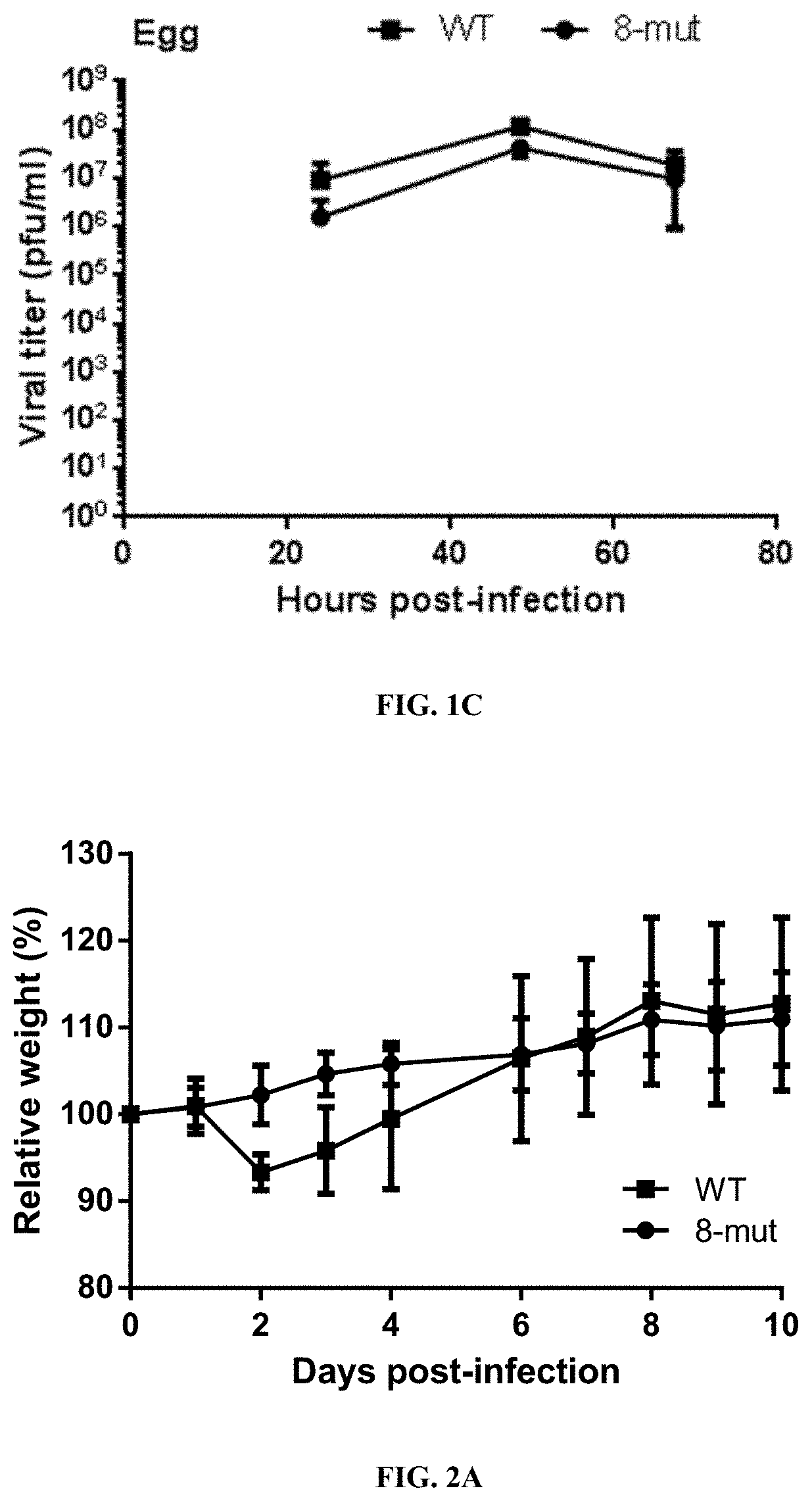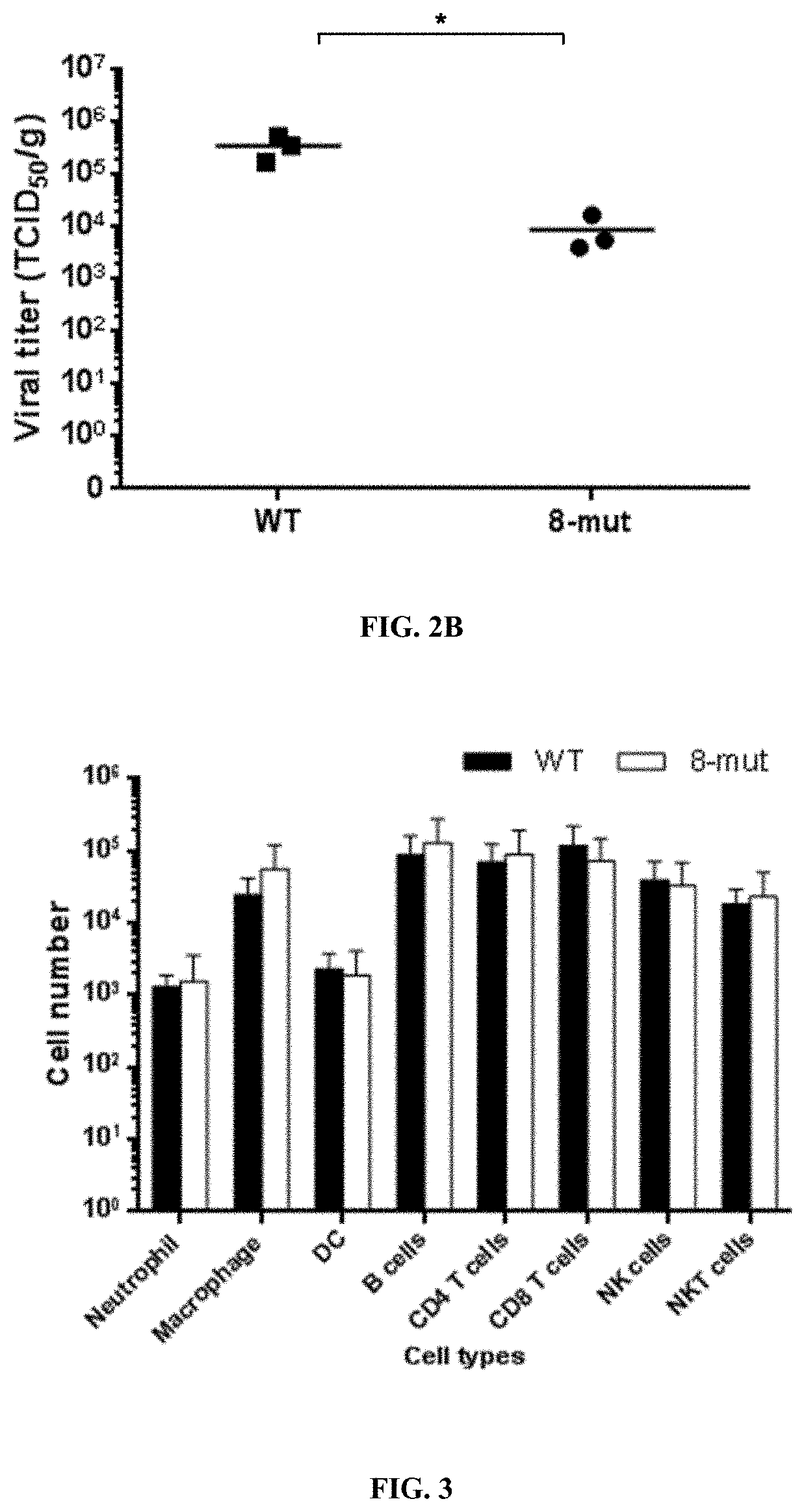Live-attenuated virus and methods of production and use
a technology of live-attenuated viruses and production methods, applied in the field of live-attenuated viruses, can solve the problems of insufficient immunogenicity of current commercial live-attenuated vaccines to induce robust immune responses, and both types of vaccines have their limitations
- Summary
- Abstract
- Description
- Claims
- Application Information
AI Technical Summary
Benefits of technology
Problems solved by technology
Method used
Image
Examples
example 1
n of Synthetic Viral Genes and Recombinant Viruses
[0256]Materials and Methods
[0257]Influenza A / Brisbane / 59 / 2007 (H1N1) was used as the prototype virus in this study. A dataset for each viral segment from viruses that are of human or avian origin was established in our previous studies (Wong et al., BMC Evolutionary Biology, 10:253 (2010)). The codon usage bias observed from each segment-specific dataset was compared to the corresponding counterpart (e.g. human PB2 vs avian PB2). To generate a recombinant A / Brisbane / 59 / 2007 virus with the largest open reading frame (ORF) in each viral segment has an avian-like viral codon usage bias, the segment-specific codon usage frequency of wild-type A / Brisbane / 59 / 2007 with those deduced from the avian influenza sequences was compared. The analysis allowed to determine the number of mutations required to be introduced into the prototype virus for changing its codon bias from human-like to avian-like (Tables 6 and 7 and SEQ ID NOs: 1-16). In orde...
example 2
Virus is Attenuated in Mammalian Cells and in Mice
[0270]Materials and Methods
[0271]Virus replication kinetics of the WT and 8-mut viruses were determined in mammalian cells (MDCK and A549 cells) and embryonated eggs. To evaluate whether this virus was attenuated in mice, groups of 5 female BALB / C mice were infected intranasally with 6.75×105 p.f.u. of the WT or 8-mut virus. To determine whether the 8-mut virus still capable of inducing neutralizing antibodies in vivo, serum samples from infected mice were examined by microneutralization assay at 28 days post-infection. Groups of female BALB / c mice (N=3) were infected intranasally with 6.75×105 p.f.u. of WT or 8-mut viruses. Sera were collected at 28 day post-infection for microneutralization assay against WT, and 8-mut viruses. Equal volume of sera from each mouse under the same group was pooled for the analysis. Sera were heat inactivated and serially 2-fold diluted from 1:10 to 1:1280. Sera were added to neutralize 100 TCID50 / 35 μ...
example 3
Virus Protects Mice from Viral Challenge
[0281]Materials and Methods
[0282]In order to determine whether the 8-mut can induce immune protection in mice, infected mice were subsequently subjected to a homologous or a heterologous challenge. Groups of 6 BALB / c mice were vaccinated intranasally with 6.75×105 p.f.u. of 8-mut virus, or were mock-vaccinated with PBS. Vaccinated or mock vaccinated mice were challenged with 4.3×105 p.f.u. of mouse-adapted A / Brisbane / 59 / 07 virus (MA-WT) virus at day 28 post-vaccination. Lung tissues from treated mice were harvested at day 3 and 7 post-challenge for viral titration and immunohistochemistry staining.
[0283]Results
[0284]As the WT virus could only cause a mild weigh loss in mice (FIG. 2A), a more pathogenic mouse-adapted A / Brisbane / 59 / 07 virus (MA-WT) (Xu et al., PLoS ONE, 6(12):e28901 (2011)) was used in the challenge. The PBS-vaccinated mice displayed moderate ruffling fur and mild hunching posture, and had significant weight loss (FIG. 4A). By c...
PUM
| Property | Measurement | Unit |
|---|---|---|
| temperature | aaaaa | aaaaa |
| temperatures | aaaaa | aaaaa |
| body temperature | aaaaa | aaaaa |
Abstract
Description
Claims
Application Information
 Login to View More
Login to View More - R&D
- Intellectual Property
- Life Sciences
- Materials
- Tech Scout
- Unparalleled Data Quality
- Higher Quality Content
- 60% Fewer Hallucinations
Browse by: Latest US Patents, China's latest patents, Technical Efficacy Thesaurus, Application Domain, Technology Topic, Popular Technical Reports.
© 2025 PatSnap. All rights reserved.Legal|Privacy policy|Modern Slavery Act Transparency Statement|Sitemap|About US| Contact US: help@patsnap.com



